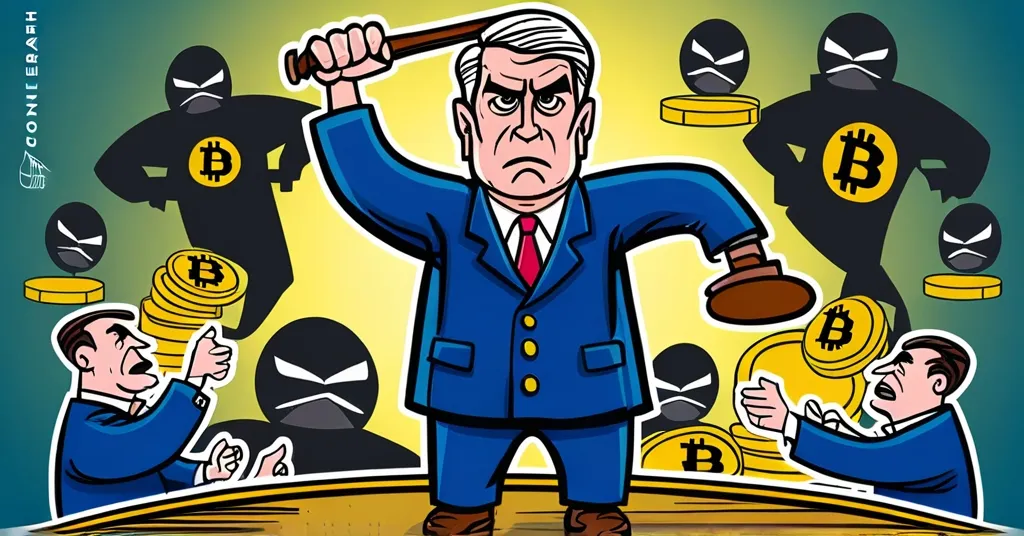Gary Gensler Slams Crypto: Non-Compliance and Bad Actors Under Scrutiny

Gary Gensler’s Parting Shot: Crypto Market Under Fire
Outgoing SEC Chair Gary Gensler has delivered a scathing critique of the cryptocurrency market, highlighting its struggles with compliance and the presence of “bad actors.” In his final interview, Gensler’s comments underscore the regulatory challenges facing the sector, despite it representing less than 1% of the US capital markets.
- Gensler criticizes crypto market’s non-compliance
- SEC’s enforcement actions surge under Gensler
- Bitcoin’s unique position among sentiment-driven projects
Gensler’s Critique of the Crypto Market
With only days left in his term, appointed by President Joe Biden, Gensler has been at the forefront of overseeing the volatile crypto market. He emphasized the disproportionate regulatory demands the sector places on the SEC, despite its small share of the $120 trillion US capital markets. Non-compliance with securities laws, which means failing to meet the legal standards set for securities, has been a major concern. Gensler bluntly stated, “It’s a field that built up around non-compliance,” pointing to the inherent challenges in regulating digital assets.
Gensler further criticized the crypto market for being driven more by sentiment than by solid fundamentals. When he refers to projects as “sentiment-driven,” he’s talking about investments based on hype and speculation rather than tangible business models or earnings. He compared many crypto projects to venture capital investments, which are known for their high risk and high reward nature, warning, “Many of them will not survive. They’re like venture capital investments. They’re not going to survive.”
SEC Enforcement Actions
Under Gensler’s leadership, the SEC ramped up its efforts, bringing about 100 enforcement actions against crypto-related entities, compared to 80 under his predecessor, Jay Clayton. This surge in regulatory action aimed to protect investors from the volatility and fraudulent schemes that have riddled the crypto market. In the crypto world, the only thing more volatile than the prices is the regulatory scrutiny.
High-profile cases under Gensler’s watch included those against Sam Bankman-Fried of FTX, Changpeng Zhao (CZ) of Binance, and Do Kwon of Terraform Labs. These actions resulted in significant investor losses, highlighting the SEC’s commitment to cracking down on fraud and non-compliance. The Terraform Labs case, for example, led to a $4.5 billion settlement, showcasing the severity of regulatory actions against those who breach investor trust.
Bitcoin’s Distinction
While Gensler was critical of the broader crypto market, he distinguished Bitcoin, which accounts for 67-80% of the crypto market value, from other projects. At the time of his remarks, Bitcoin was trading at $93,253. Gensler noted that Bitcoin’s dominance in the market sets it apart from the thousands of other projects driven by sentiment rather than fundamentals. This distinction highlights Bitcoin’s unique position and the challenges of regulating a diverse and rapidly evolving market.
Counterpoints and Broader Context
Gensler’s regulatory approach has sparked debate within the crypto community. Some argue that his aggressive stance stifles innovation, a key pillar of the decentralized ethos that many in the crypto space champion. Crypto advocate Brian Armstrong of Coinbase, for instance, has argued, “Regulation is crucial, but it must be balanced with the need to foster innovation and growth in the sector.”
While the SEC’s role in ensuring market integrity and investor protection is vital, the spirit of decentralization and freedom in crypto shouldn’t be stifled. Gensler’s shift from academic exploration at MIT to regulatory enforcement reflects the complexities of governing a rapidly evolving industry. His time at MIT provided him with a deep understanding of digital assets, which he has used to shape his regulatory approach at the SEC.
Future Outlook
Looking ahead, Gensler predicted a challenging future for many crypto projects, suggesting that the current market enthusiasm might not be sustainable for all players. This prediction aligns with the SEC’s ongoing efforts to protect investors from the risks associated with the crypto market’s volatility and fraudulent schemes.
As we stand at the crossroads of innovation and regulation, the future of the crypto market remains uncertain. While regulation is necessary to protect investors and ensure market integrity, the ethos of effective accelerationism (e/acc) and the drive towards decentralization must also be considered. Gensler’s parting words serve as a stark reminder of the challenges ahead, but also of the potential for a more robust and compliant crypto ecosystem.
Key Takeaways and Questions
- What was Gary Gensler’s view on the cryptocurrency market?
Gensler viewed the crypto market as “rife with bad actors” and characterized by non-compliance with securities laws.
- How does the SEC’s enforcement activity under Gensler compare to his predecessor?
Under Gensler, the SEC brought about 100 enforcement actions, compared to 80 under Jay Clayton.
- What percentage of the US capital markets does the crypto sector represent?
The crypto sector accounts for less than 1% of the $120 trillion US capital markets.
- How did Gensler distinguish Bitcoin from other crypto projects?
Gensler noted that Bitcoin accounts for 67-80% of the crypto market value, while the other projects are largely sentiment-driven and lack solid fundamentals.
- Which high-profile figures did Gensler mention in relation to enforcement actions?
He mentioned Sam Bankman-Fried, CZ (Changpeng Zhao), and Do Kwon, all of whom were involved in significant cases leading to investor losses.
- What is Gensler’s prediction for the future of many crypto projects?
Gensler predicted that many of these projects would not survive, likening them to venture capital investments.
- How did Gensler’s approach to crypto differ from his time at MIT?
At MIT, Gensler studied digital assets from an academic perspective, whereas at the SEC, his focus was on regulatory enforcement and protecting investors from the crypto market’s challenges.
“It’s a field that built up around non-compliance.”
“This field, it’s rife with bad actors.”
“I’ve never seen a field that’s so much wrapped up in sentiment and not so much about fundamentals.”
“Many of them will not survive. They’re like venture capital investments. They’re not going to survive.”



